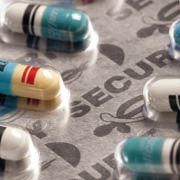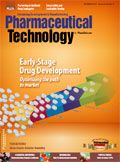Protecting the Public
Overt and covert packaging technologies evolve to authenticate drugs and fight counterfeits.
There have been some victories in the fight against counterfeit and gray market drugs. After admitting he distributed adulterated and counterfeit drugs, James Newcomb of La Jolla, CA, received a 24-month prison sentence from the US District Court for the Eastern District of Missouri. As part of the February 2012 plea deal, he also forfeited $1.4 million and a Land Rover (1).
Legal requirements
The US Congress, however, wants harsher punishment for offenses involving counterfeit drugs. Under the FDA Safety and Innovation Act, signed by President Obama in July 2012, the Attorney General shall give increased priority to efforts to investigate and prosecute these criminals. In addition, the US Sentencing Commission is to consider increased penalties for drug counterfeiting (2).

Hallie Forcinio
Meanwhile, regulators worldwide are working to protect consumers. In the European Union, the Falsified Medicines Directive 2011/62/EU takes effect on Jan. 2, 2013 (3). The Directive requires authentication features on individual prescription-drug packs to enable verification throughout the supply chain. It also strengthens requirements for control and inspection of manufacturers of active substances. Manufacturers also must report any suspicion of falsified medicines. Other provisions give penalties for the manufacturing, distribution, import, and export of falsified medicinal products and point out the dangers associated with sale of medicines via the Internet.
Regulatory initiatives
With a significant percentage of medicines purchased from Internet sites found to be counterfeit, FDA has embarked on a public education campaign, BeSafeRx: Know Your Online Pharmacy (4).
Another tool used by FDA is its October 2011 Guidance for Industry: Incorporation of Physical-Chemical Identifiers into Solid Oral Dosage Form Drug Products for Anticounterfeiting (5). FDA is also training field agents in the use of a handheld device to check for counterfeit products and packaging arriving at ports of entry. The CD3 (Counterfeit Detection Device #3) emits light in 10 wavelengths to check API and drug samples against stored scans. It also detects package tampering.
Other organizations are hard at work too. The World Health Organization’s (WHO) Working Group of Member States on Substandard/Spurious/Falsely-Labelled Falsified/Counterfeit Medical Products takes a three-pronged approach: education, norms and standards, and technical support to countries (6). WHO also supports the International Medical Products Anti-Counterfeiting Taskforce, a group it launched in 2006 with a wide range of partners including international organizations, nongovernmental organizations, enforcement agencies, pharmaceutical manufacturers’ associations, and drug and regulatory authorities.
The US Agency for International Development (USAID) provides technical assistance worldwide to identify fake and substandard products and help legitimate manufacturers meet internationally recognized good manufacturing practices. In some cases, its efforts are implemented by the United States Pharmacopeial Convention (USP).
USP has increased its outreach efforts as well. A proposed USP sub-Saharan Africa Center for Pharmaceutical Advancement and Training (CePAT) in Accra, Ghana, will provide training in quality control and good manufacturing practices as well as laboratory testing and consulting services for the region. The USP Board of Trustees is requesting donations to cover construction costs beyond the $1.5 million it has committed to the project. Donations also are needed to purchase instrumentation for the training laboratories, hire staff, and subsidize the Center’s first three years of operation. Expected to be self-sustaining by year four, the CePAT in Ghana will serve as a model for future operations in Asia and South America. The effort is the first initiative of USP’s Global Health Impact Program and is a successor to Promoting the Quality of Medicines (PQM) and predecessor programs that targeted specific African countries and diseases.
“The work that USP has been able to do through the PQM program has opened our eyes to new opportunities to provide assistance in sub-Saharan Africa,” explained Patrick Lukulay, vice-president of global health impact programs at USP, in a press release (7). “Our ability to do long-term work in Africa through this center in Ghana will improve health of patients in the region who are desperate for medicines they can trust.”
USP also is finalizing General Chapter <1083> Good Distribution Practices—Supply Chain Integrity. It will outline best packaging practices to combat counterfeit drugs and medical devices. Likely topics include tamper-evident designs, authentication technologies, serialization, pedigrees, machine-readable data carriers, repackaging, and information retention and security.
The European Federation of Pharmaceutical Industries and Associations (EFPIA) is collaborating in efforts to combat counterfeit drugs. One project, the European Stakeholder Model, advocates the use of two-dimensional barcoding technology to authenticate products and comply with the Falsified Medicines Directive. This serialization system will be run by stakeholder organizations on a nonprofit basis.
“Potential advantages include the possibility of allowing for the automated checking of expiry dates, better pharmacovigilance, a reduction in the number of fraudulent reimbursement claims, higher effectiveness in preventing recalled products from being supplied to the patient, more efficient handling of product returns, and improved stock management processes for pharmacies,” said Camilla Kent Hansen, market access manager for EFPIA, in a recent article (8).
Evolving technologies
For brand owners and makers of generic- drug products and dietary supplements, a constantly evolving array of anticounterfeiting technologies help discourage counterfeiting and authenticate product.
Taggant- and ink-based approaches are particularly popular, but other technologies like holograms and security materials also are available.
Taggants. Taggants are microscopic/nano materials or chemistries that are uniquely encoded and virtually impossible to duplicate—like a fingerprint. The invisible taggants work at a low loading ratio yet are identifiable in the field via a handheld tester. Taggants can be delivered in raw material, plastic masterbatch, security ink, or spray carrier. Some taggants make it possible to detect mix ratios and dilution as low as 10% (Molecular Taggants, Microtrace).
Some taggant technology can be paired with smartphone authentication, thus eliminating the need for proprietary readers and opening the door to consumer-level authentication (TagSure taggant technology, SmartSure phone app, InkSure Technologies).
Taggant-equipped labels and cartons can be printed with invisible ink and item-level codes for authentication (taggants and inks, Covectra, labels and cartons from MSO Group). Software makes the covert technology compatible with serialization and track-and-trace requirements (AuthentiTrack software, Covectra).
Ink-based approaches. A technology with some similarity to taggants adds a standard or custom DNA strand to a visible or invisible security ink applied by a continuous inkjet printer. To authenticate the product, a sample is extracted from the printed component, loaded into a PCR reaction plate, and analyzed to confirm the presence of the DNA (Security Fluids, Oncode, a division of Gem Gravure, with DNA strands from DNA Technologies, a division of Polestar).
Another covert solution prints an invisible pattern of seemingly random microdots along with other graphic elements. A standard office scanner captures the resulting image for storage on a secure server and future authentication via an iPhone app (Cryptoglyph covert printed patterns, Genuine or Fake iPhone app, AlpVision).
Visible color security inks for continuous inkjet printers can be matched to a brand’s logo or other graphic elements, so brand owners can add security features without noticeable changes to the package’s appearance. A clear version of the security ink is also available. Proprietary markers in the ink are only visible to a custom reader (Traceless System, Eastman Kodak).
Continuous inkjet printers also apply unique codes or other data with ultraviolet (UV) inks. The covert codes can support authentication and track-and-trace functions (Linx Clear UV-readable inks 1121 and Linx 4900 CIJ printer, Linx Printing Technologies).
Another UV-based solution applies UV-ink-printed roll-fed labels to syringe barrels during the molding process. Labels are placed within +/- 0.010 in. to ensure dosage markings are accurately positioned. The in-mold labeling process eliminates the need for a secondary pad-printing or labeling operation (in-mold labeling cell, CBW Automation, 45-micron labels, Inland Label).
Holograms. Holograms continue to be a popular authentication tool and can be applied to a variety of packaging materials and labelstock. Holograms can incorporate covert features and/or be combined with other anticounterfeiting features such as micro letters, color-shifting ink, embossing, temperature-sensitive ink, UV ink, and digital watermarks. Traditional embossed holograms provide a horizontal three-dimensional effect, plus high resolution and luminance. More difficult-to-counterfeit Lippmann Holograms rely on a laser-based production process. Vertical as well as horizontal three-dimensional effects present a more true-to-life image that is visible from any angle. Combining multiple images produces an animated effect. The addition of a two-dimensional barcode adds traceability functionality (Secureimage Hologram, DNP America).
Security materials. Security paper relies on random fiber orientation in the paper media to ensure each label, tag, or seal possesses its own fingerprint for authentication. A unique printed identifier, such as a QR, two-dimensional, or alphanumeric code on each label, links to a random embedded fiber image. The fiber image and code are recorded during printing and stored for instant recall and comparison when an end user verifies authenticity with a smartphone or other device (Neenah Secure Labels with the Prooftag Security System, Neenah Paper).

Figure 1: Non-removable features are laser-etched during the rolling process to produce difficult-to-duplicate foil for blisters, flexible packaging or induction seals (CPI Security Foil, Constantia Flexibles).
Difficult-to-copy security foil is available for push-through, child-resistant, or cold-formed blisters, pouches, sachets, and induction seals (see Figure 1). Fine-line graphics, text, logos, and micro-features are laser-etched into the surface of the foil during the rolling process and cannot be removed (CPI Security Foil, Constantia Flexibles).
A multipart label with integrated covert inscriptions helps prevent empty vials from being refilled with fake drugs and resold. Removing the label’s tear strip, which also encircles the cap, reveals the messages, “Opened” and “Used” (see Figure 2). This makes the undetected reuse of a glass container with an original label virtually impossible (Pharma-Comb Void Label, Schreiner MediPharm).

Figure 2: Removing the tear strip on the label reveals messages showing the container has been opened and discourages improper reuse (Pharma-Comb Void Label, Schreiner Medipharm).
Another brand-protecting label, already in use on audio equipment like microphones, combines overt and covert features. One area reveals different colors under direct light, and the last character of the alphanumeric security code is repeated in an enlarged format. Codes can be quickly checked online to confirm product authenticity at any point in the supply chain. The pressure-sensitive labels also can include a two-dimensional DataMatrix code (tesa PrioSpot technology, tesa scribos).
References
1. US Attorney’s Office, Eastern District Of Missouri, “California Man Sentenced for Importing Adulterated Cancer Drugs; Forfeits $1.4 Million and Land Rover Automobile,” Press Release (St. Louis, Mo., August 23, 2012).
2. S. 3187, US Senate, 112th Congress, 2nd Session (Washington, DC), June 27, 2012.
3. EC Directive 2011/62/EU, Falsified Medicines Directive (Brussels, July 2011).
4. FDA, “Buying Medicines Online? Be Wary, FDA Says,” Consumer Updates, http://www.fda.gov/ForConsumers/ConsumerUpdates/ucm321121.htm, accessed Oct. 3, 2012.
5. FDA, Guidance for Industry: Incorporation of Physical-Chemical Identifiers into Solid Oral Dosage Form Drug Products for Anticounterfeiting (Silver Spring, MD, Oct. 2011).
6. WHO, “Medicines: Spurious/Falsely-Labelled/ Falsified/Counterfeit (SFFC) Medicines, Fact Sheet No 275, May 2012,” http://www.who.int/mediacentre/factsheets/fs275/en/, accessed Oct. 3, 2012.
7. USP, “Reducing the Threat of Counterfeits, Investing in the Future of Safe Medicines,” Press Release (Rockville, MD, April 09, 2012).
8. EFPIA, “Tackling the Rise of Counterfeit Medicines,” http://www.efpia.eu/news/tackling-rise-counterfeit-medicines, accessed Oct. 1, 2012.
Hallie Forcinio is Pharmaceutical Technology's Packaging Forum editor, 4708 Morningside Drive, Cleveland, OH 44109, tel. 216.351.5824, fax 216.351.5684, editorhal@cs.com.

Drug Solutions Podcast: A Closer Look at mRNA in Oncology and Vaccines
April 30th 2024In this episode fo the Drug Solutions Podcast, etherna’s vice-president of Technology and Innovation, Stefaan De Koker, discusses the merits and challenges of using mRNA as the foundation for therapeutics in oncology as well as for vaccines.
Entering New Domains for 3D Printing of Drug Products
April 6th 20253D printing of personalized medications is currently possible under existing compounding regulations, offering enhanced process control through automation. But new legislation coming in 2025 will allow 3D printing as part of a distributed manufacturing framework.